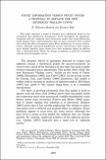| dc.contributor.author | Mankiw, N. Gregory | |
| dc.contributor.author | Reis, Ricardo | |
| dc.date.accessioned | 2009-11-20T19:16:03Z | |
| dc.date.issued | 2002 | |
| dc.identifier.citation | Mankiw, N. Gregory, and Ricardo Reis. 2002. Sticky information versus sticky prices: A proposal to replace the new Keynesian Phillips curve. Quarterly Journal of Economics 117(4): 1295-1328. | en_US |
| dc.identifier.issn | 0033-5533 | en_US |
| dc.identifier.uri | http://nrs.harvard.edu/urn-3:HUL.InstRepos:3415324 | |
| dc.description.abstract | This paper examines a model of dynamic price adjustment based on the assumption that information disseminates slowly throughout the population. Compared with the commonly used sticky-price model, this sticky-information model displays three related properties that are more consistent with accepted views about the effects of monetary policy. First, disinflations are always contractionary (although announced disinflations are less contractionary than surprise ones). Second, monetary policy shocks have their maximum impact on inflation with a substantial delay. Third, the change in inflation is positively correlated with the level of economic activity. | en_US |
| dc.description.sponsorship | Economics | en_US |
| dc.language.iso | en_US | en_US |
| dc.publisher | Massachusetts Institute of Technology Press | en_US |
| dc.relation.isversionof | http://dx.doi.org/10.1162/003355302320935034 | en_US |
| dash.license | LAA | |
| dc.title | Sticky Information Versus Sticky Prices: A Proposal to Replace the New Keynesian Phillips Curve | en_US |
| dc.type | Journal Article | en_US |
| dc.description.version | Proof | en_US |
| dc.relation.journal | Quarterly Journal of Economics -Cambridge Massachusetts- | en_US |
| dash.depositing.author | Mankiw, N. Gregory | |
| dc.date.available | 2009-11-20T19:16:03Z | |
| dc.data.uri | http://hdl.handle.net/1902.1/10495 | en_US |
| dc.identifier.doi | 10.1162/003355302320935034 | * |
| dash.contributor.affiliated | Mankiw, N | |


